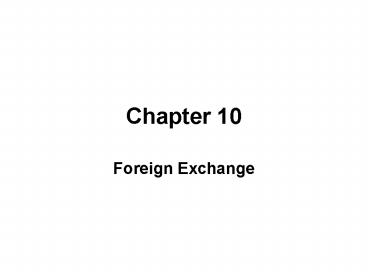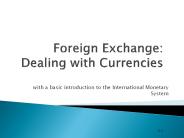Foreign Exchange - PowerPoint PPT Presentation
1 / 40
Title:
Foreign Exchange
Description:
... Exchange Rates ... Exchange rates are determined in markets by the interaction of supply ... Exchange Rates in the Long Run: Theory of Purchasing Power ... – PowerPoint PPT presentation
Number of Views:79
Avg rating:3.0/5.0
Title: Foreign Exchange
1
Chapter 10
- Foreign Exchange
2
Foreign Exchange Market How is Foreign Exchange
Traded?
- The trading of currencies and banks deposits is
what makes up the foreign exchange market. - FX traded in over-the-counter market
- Most trades involve buying and selling bank
deposits denominated in different currencies. - Trades in the foreign exchange market involve
transactions in excess of 1 million. - Typical consumers buy foreign currencies from
retail dealers, such as American Express.
3
Exchange Rates
- Foreign Exchange Markets
- On an average day in 2001,
- 1.2 trillion in foreign currency was traded in a
market that operates 24 hours a day - The U.S. dollar is one side of roughly 90 of
these currency transactions. - Majority of transactions take place in London.
4
Exchange Rates
Note the difference in rate fluctuations during
the period. Which appears most volatile? The
least?
5
Exchange Rates
6
Exchange Rates
7
The Foreign Exchange Market
- Definitions
- Spot exchange rate
- Spot rates are the rates for an immediate
exchange - Forward exchange rate
- The rates at which foreign currency dealers are
willing to commit to buying or selling a currency
in the future - They give some indication of whether market
participants expect currencies to appreciate or
depreciate over time. - Appreciation
- A decline in the value of one currency relative
to another is called depreciation. - Depreciation
- The rise in the value of one currency relative to
another is called an appreciation.
8
Foreign Exchange Market Why Are Exchange Rates
Important?
- When the currency of your country appreciates
relative to another country, your country's goods
prices ? abroad and foreign goods prices ? in
your country. - Makes domestic businesses less competitive
- Benefits domestic consumers (you)
9
Exchange Rates
- Real Exchange Rates
- The rate at which one can exchange the goods and
services from one country for the goods and
services from another country. - It is the cost of a basket of goods in one
country relative to the cost of the same basket
of goods in another country.
10
Exchange Rates in the Long Run
- Exchange rates are determined in markets by the
interaction of supply and demand. - An important concept that drives the forces of
supply and demand is the Law of One Price. - By convention, we quote, the exchange rate, (E)
as units of foreign currency / units of the
domestic. - Euros/dollars
- The euro-dollar exchange rate is the number of
euro you can get for each dollar. - In Japan
- US dollar/Yen
11
Exchange Rates in the Long Run Law of One Price
- The Law of One Price
- The price of an identical good will be the same
throughout the world, regardless of which country
produces it. - Purchasing Power Parity
- The dollar price of a basket of goods and
services in the United States should be the same
as the dollar price of a basket of goods and
services in Mexico, Japan, or the United Kingdom.
- Example American steel 100 per ton, Japanese
steel 10,000 yen per ton
12
Exchange Rates in the Long Run Law of One Price
- Law of one price ? E 100 yen/
13
Exchange Rates in the Long Run Theory of
Purchasing Power Parity (PPP)
- The theory of PPP states that exchange rates
between two currencies will adjust to reflect
changes in price levels. - PPP ? Domestic price level ? 10, domestic
currency ? 10 - Application of law of one price to price levels
- The currency of a country with high inflation
will depreciate
14
Exchange Rate in the Long-run
15
The Dollar and Interest Rates
- Value of and real rates rise and fall together,
as theory predicts - No association between and nominal rates
falls in late 1970s as nominal rate rises
16
Exchange Rates in the Long Run Theory of
Purchasing Power Parity (PPP)
- Problems with PPP
- All goods are not identical in both countries
- Not perfect substitutes
- (i.e., Toyota versus Chevy)
- Many goods and services are not traded (e.g.,
haircuts, land, etc.) - Helps to explain why it does not hold for all
goods - Other reasons why PPP does not hold
- Significant Transportation costs
- Tariffs
- Different tastes and preferences
- Non-traded goods
17
Chapter 13
18
Factors Affecting Exchange Rates in Long Run
- To understand how exchange rates shift in time,
we need to understand the factors that shift
expected returns for domestic and foreign
deposits. - Basic Principle
- When a factor increases demand for domestic goods
relative to foreign goods - The exchange rate ?, domestic currency
depreciates - Four major factors
- Relative price levels
- Preferences for domestic v. foreign goods
- Productivity.
- tariffs and quotas
19
Factors Affecting Exchange Rates in Long Run
- Relative price levels
- A rise in relative price levels cause a countrys
currency to depreciate. - Preferences for domestic v. foreign goods
- Increased demand for a countrys goods causes its
currency to appreciate - Increased demand for imports causes the domestic
currency to depreciate.
20
Factors Affecting Exchange Rates in Long Run
- Productivity
- If a country is more productive relative to
another, its currency appreciates. - Tariffs and quotas
- Increasing trade barriers causes a countrys
currency to appreciate.
21
Factors Affecting Exchange Rates in Long Run
22
Exchange Rate in the Short-run
23
Explaining Changes in Exchange Rates
24
Explaining Changes in Exchange Rates
25
Government Policy and Foreign Exchange
Intervention
- Government officials can intervene in foreign
exchange markets in several ways. - policymakers will buy or sell currency in an
attempt to affect demand or supply - adopting a fixed exchange rate and act to
maintain it at a level of their choosing. - Foreign exchange interventions
- Generally ineffective because FX is the only
thing that the government can control. - That is the reason countries like the United
States rarely intervene in the foreign exchange
markets.
26
Chapter 19
- Exchange Rate Policy and the Central Bank
27
Linking Exchange Rate Policy with Domestic
Monetary Policy
- Purchasing Power Parity
- In the long run, changes in the exchange rate are
tied to differences in inflation. - The central bank must choose between a fixed
exchange rate and an independent inflation
policy it cannot have both.
28
Linking Exchange Rate Policy with Domestic
Monetary Policy
- Capital Controls and the Policymakers Choice
- A country cannot
- Be open to international capital flows,
- Control its domestic interest rate, and
- Fix its exchange rate.
- Policymakers must choose two of these three
options.
29
Exchange Rate Regimes
- What are fixed Exchange Rates?
- Officials commit to maintaining the exchange rate
at a specific level. - A fixed exchange rate means giving up domestic
monetary policy. - Fixed exchange rates are government controlled.
- What are Floating Exchange Rates?
- No intervention from bankers or government
officials. The market determines the price of the
currency - Floating exchange rates are market driven.
30
Fixed Exchange Rates
- How can the government keep a currency at a
certain value if international commerce becomes
unwilling to pay that price? - It cant maintain the value for long. If the
demand for the currency falls, its price would
fall as well. - To what does the government fix the value of its
currency? - When or how often does the country change the
value of its fixed rate?
31
The Mechanics of Exchange Rate Management
- The decision to control the exchange rate means
giving up control of the size of reserves, so
that the market determines the interest rate. - A foreign exchange intervention has the same
impact on reserves as a domestic open market
operation.
32
The Mechanics of Exchange Rate Management
33
The Mechanics of Exchange Rate Management
- A foreign exchange intervention affects the value
of a country's currency by changing domestic
interest rates - Any central bank policy that influences the
domestic interest rate will affect the exchange
rate - An intervention is unsterilized if it changes the
monetary base and sterilized if it does not
change the monetary base.
34
The Costs, Benefits, and Risks of Fixed Exchange
Rates
- A country will be better off fixing its exchange
rate if it has - A poor reputation for controlling inflation on
its own - An economy that is well integrated with the one
to whose currency the rate is fixed, trading
significantly with it and sharing similar
macroeconomic characteristics and - A high level of foreign exchange reserves.
35
Fixed Exchange Rates
- The only way the price can be kept up is for the
government promising to maintain the original
level to enter the foreign exchange market and
bid the price of the currency back up by
purchasing it.
36
Fixed Exchange Rates
- The government must buy the amount that will
bring the quantity demanded back to the original
level.
Price of Franc
Supply of Francs
Demand for Francs
Quantity of exchange
37
Fix to what?
- In the past, all currencies were fixed to gold.
- Today, a country can fix its value to another
countrys currency. - A country can fix its currency to a basket of
other currencies. - Same as diversifying a portfolio (Not putting all
your eggs in one basket) - Special Drawing Right (SDR)A basket of four
major world currencies.
38
When to Change the Rate?
- Why might a government want to change the
exchange value of its currency? - It might do so in order to promote, for example,
greater export volume. - What is a pegged exchange rate?
- The term pegged exchange rate refers to setting a
targeted value for a countrys foreign exchange,
and it indicates the govt. has some ability to
move the peg.
39
The Floating Exchange Rate
- Clean Float
- Supply and Demand are solely private activities
- Complete flexibility
- Dirty Float (Managed Float)
- From time to time, the government tries to impact
the rate through intervention - More popular than clean float
- Effectiveness of intervention is controversial
40
Fixed and Floating Rates
- Fixing the exchange rate deprives a government of
two very valuable policy instruments - the nominal exchange rate monetary policy
- Fixing the exchange rate may help stabilize a
country that has suffered extensively with
inflation. - The commitment to a pegged exchange rate is
implicitly a commitment to monetary and fiscal
stability - without which a fixed rate cannot survive.
Pegging can buy credibility.































